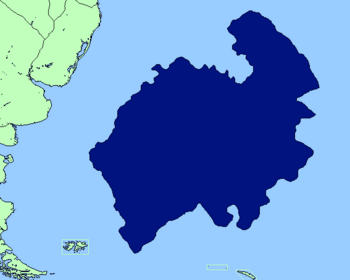Longinor
This article is incomplete because it is pending further input from participants, or it is a work-in-progress by one author. Please comment on this article's talk page to share your input, comments and questions. Note: To contribute to this article, you may need to seek help from the author(s) of this page. |
Imperial Republic of Longinor República Imperial da Longenória República Imperial de Longenoria Ronginō Teikoku Kyōwakoku Repubblica Imperiale di Longinoria Rikenrepublik da Langinor | |
|---|---|
| Motto: "Abençoados Sejam os Pacificadores" "Benditos sean los Pacificadores" "Beati gli Operatori di Pace" "Heiwa o tsukuridasu hitobito wa saiwaidearu" "Velsina seian der Friddare" "Blessed be the Peacemakers" | |
| Anthem: "Ode to the Atlantic" | |
 Longinor, in the landmass of Bartoloterra | |
| Location | Neotopia |
| Capital | Amarantina |
| Largest city | Entremontes |
| Official languages | English Portuguese Spanish Japanese Alemanisk Italian |
| Ethnic groups (2021) | 31.26% Luso-Longinorian 24.41% Anglo-Longinorian 14.42% Hispano-Longinorian 8.38% Afro-Longinorian 8.17% Nipo-Longinorian 4.29% Alemanisker 3.01% Italo-Longinorian 6.06% Others |
| Religion (2021) | 34.75% Athena-Nhamandu Followers (Official) 21.42% Roman Catholic 10.63% Lutheran 6.28% Pentecostal Christian 5.87% Spiritist 5.21% Eastern Orthodox 4.55% Other Religions 3.96% Non-theist 3.37% Afro-Diaspora Religions 2.5% Other Christian 0.89% Atheist 0.8% Judaism |
| Demonym(s) | Longinorian |
| Government | Federal parliamentary republic |
| Legislature | Imperial Parliament |
| The Senate | |
| The Forum | |
| Independence from Portugal and Spain | |
• Declared | 18 April 1812 |
• Recognized | 5 May 1820 |
• Admission of Elizabethland | 10 June 1832 |
• The Athenian Revolution | 12 March 1924 |
• Current Constitution | 17 December 2002 |
| Area | |
• Total | 5,623,432 km2 (2,171,219 sq mi) |
| Population | |
• 2022 estimate | 189,712,901 |
• Density | 33.73/km2 (87.4/sq mi) |
| GDP (nominal) | 2021 estimate |
• Total | $5.697 trillion |
• Per capita | $31,458 |
| Gini (2021) | 38.9 medium |
| HDI (2021) | very high |
| Currency | Goldshield (GD$) (LDM) |
| Time zone | UTC-3 -2 |
| Date format | dd-mm-yyyy (CE) |
| Driving side | right |
| Calling code | +593 |
| ISO 3166 code | LO |
| Internet TLD | .lo |
Longinor (Portuguese: Longenória; Spanish: Longenoria; Japanese: Ronginō; Italian: Longinoria; Alemanisk: Langinor), officially the Imperial Republic of Longinor (Portuguese: República Imperial da Longenória; Spanish: República Imperial de Longenoria; Japanese: Ronginō Teikoku Kyōwakoku; Italian: Repubblica Imperiale di Longinoria; Alemanisk: Rikenrepublik da Langinor), is a country in the continent of Neotopia. It is the richest country in Neotopia and the second-largest in both area and population. Its capital is the former Portuguese colony of Amarantina, although the largest city is Entremontes, a multicultural city and one of the continents' few global cities. The country is composed of a union of 3 regions, subdivided into states. It is a multicultural country with no clear ethno-religious majority. The Imperial Republic is the only nation in the Vespuccian Supercontinent to have Japanese as an official language.
Etymology
The name Longinor is the English translation of Longenória, a Portuguese toponym that means "Faraway Land". In fact, the name Longenória was adopted by the Portuguese colonists to refer to the Portuguese colonies located in the landmass of Bartoloterra (Bartolomeu's Land in Portuguese). In 1812, when Portuguese and Spanish settlers forged an alliance to expel Spanish and Portuguese loyalists, the Pombinhas Agreement led to the creation of the country of Longinor. Eventually, the former British colony of Elizabethland would join the alliance, but Longinor kept its name unchanged.
History
Previous to the European disembark in Vespuccia in 1492, the landmass of Bartoloterra was inhabited by a plethora of native groups, namely the Amerindians, whose origins can be traced back to Mongol, Polynesian, and Japanese immigrants of the Ice Age; and the Amerafros, who immigrated from Africa approximately 3000 years ago. Among these groups, there were two important pre-Columbian civilizations: the Kawadans and the Ybapirangans. The Kawadans was one of the Amerafros, masters of the art of war and seafaring. The Ybapirangans, on the other hand, were skilled astronomers who mastered the art of craftsmanship. Both civilizations, just like the Han and the Mongols, were skilled in different areas and were always at odds with each other.

